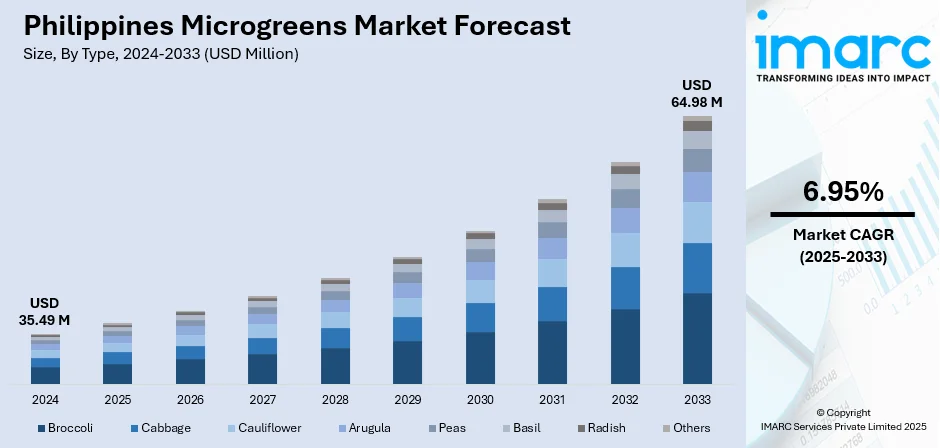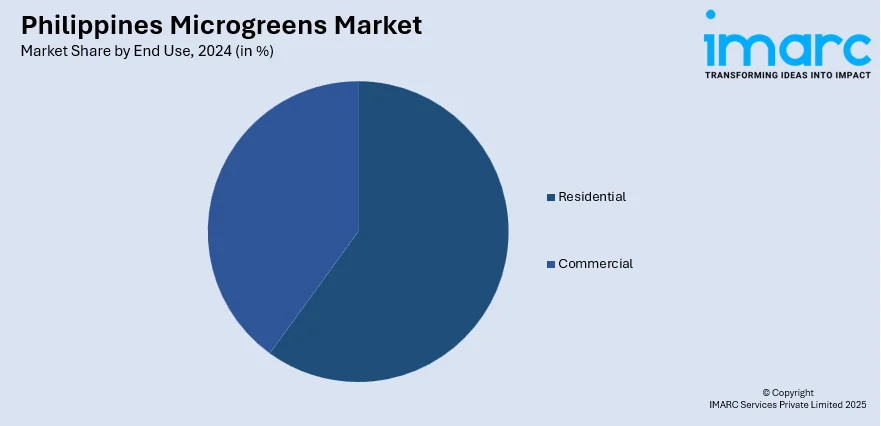
Philippines Microgreens Market Size, Share, Trends and Forecast by Type, Farming Method, End Use, Distribution Channel, and Region, 2025-2033
Philippines Microgreens Market Overview:
The Philippines microgreens market size reached USD 35.49 Million in 2024. The market is projected to reach USD 64.98 Million by 2033, exhibiting a growth rate (CAGR) of 6.95% during 2025-2033. The market is gaining momentum, propelled by growing appetite for fresh, health-forward food choices and evolving urban agriculture. Controlled-environment cultivation methods, including hydroponics and indoor vertical systems, are increasingly adopted to mitigate climate risks and support year-round production. Distribution channels span direct farm-to-table sales and specialized markets, while consumer demand is rising through both home cooks and food service establishments. Together, these factors are setting the stage for developing the Philippines microgreens market share.
|
Report Attribute
|
Key Statistics
|
|---|---|
|
Base Year
|
2024
|
|
Forecast Years
|
2025-2033
|
|
Historical Years
|
2019-2024
|
| Market Size in 2024 | USD 35.49 Million |
| Market Forecast in 2033 | USD 64.98 Million |
| Market Growth Rate 2025-2033 | 6.95% |
Philippines Microgreens Market Trends:
Urban Microgreens Adoption Speeding Up
Microgreens are fast becoming the urban farmer's mainstay across Philippines owing to their small size, fast growth, and low resource requirements. These small greens can be cultivated nearly anywhere ranging from city apartment balconies to tiny kitchen counter spaces making them particularly pragmatic in the high-density city environment. As of November 2024, a Department of Agriculture report showed microgreens as one of the easiest crops for city residents to grow, needing only elementary trays and soilless mediums such as coco coir or recycled material. Such simplicity enables even novice gardeners to participate in food cultivation without requiring soil or extensive outdoor areas. Over a gardening fad, this is part of an overall movement toward food self-reliance and food resilience, particularly in response to increasing food prices and climatic uncertainties. Government initiatives to encourage urban farming have also contributed by providing starter kits and training to families. With this trend picking up pace, microgreens are proving to be a savvy, eco-friendly alternative for fresh, locally grown produce a solution that's driving Philippines microgreens market growth in a significant, scalable fashion.

To get more information on this market, Request Sample
Smart Indoor Farming Makes Inroads through Technology
The use of intelligent technology in the cultivation of microgreens is gaining momentum in the Philippines. By availing themselves of automation, sensors, and climate control, growers in urban areas can mitigate limitations such as inadequate space, unpredictable weather, and unstable yields. As of April 2025, the Department of Science and Technology (DOST) announced increased support for indoor and vertical farming technologies across its innovation programs. These technology-based techniques, such as hydroponics and controlled-environment agriculture, enable farmers to provide perfect growing conditions throughout the year, enhancing efficiency and yields. While upfront investment in equipment and facilities can be high, long-term advantages include water conservation, increased yields, and increased market dependability. This trend towards technology-facilitated farming solutions is an indication of shifting tactics among producers, which helps microgreens better match increasing urban demand on a more regular basis. These innovations are a major force driving the changing Philippines microgreens market trends, highlighting how new styles of farming are helping this niche industry grow in the Philippines' fresh produce market.
Growing Demand from Restaurants and Specialty Markets
Microgreens are steadily gaining popularity among restaurants and specialty food markets in the Philippines. Chefs appreciate their vibrant colors, unique flavors, and concentrated nutrients, making them ideal garnishes and ingredient enhancers. As of September 2024, local industry reports indicate a noticeable increase in demand from upscale dining establishments in Metro Manila and other urban centers. These microgreens often command premium prices, positioning them as a niche product that appeals to health-conscious consumers and food enthusiasts. This rising demand encourages farmers to focus on quality and consistency, helping microgreens secure a distinct place in the local food scene. Additionally, specialty markets and health stores are expanding their offerings to include these nutrient-dense greens, tapping into growing wellness trends. While microgreens are not yet a mass-market commodity, they are driving market growth by creating premium opportunities for producers and distributors. The trend highlights a maturing market, where microgreens are becoming more than just a novelty, they are establishing themselves as a valued component in Filipino cuisine and lifestyle.
Philippines Microgreens Market Segmentation:
IMARC Group provides an analysis of the key trends in each segment of the market, along with forecasts at the country and regional levels for 2025-2033. Our report has categorized the market based on type, farming method, end use, and distribution channel.
Type Insights:
- Broccoli
- Cabbage
- Cauliflower
- Arugula
- Peas
- Basil
- Radish
- Others
The report has provided a detailed breakup and analysis of the market based on the type. This includes broccoli, cabbage, cauliflower, arugula, peas, basil, radish, and others.
Farming Method Insights:
- Indoor Vertical Farming
- Commercial Greenhouses
- Others
A detailed breakup and analysis of the market based on the farming method have also been provided in the report. This includes indoor vertical farming, commercial greenhouses, and others.
End Use Insights:

- Residential
- Commercial
The report has provided a detailed breakup and analysis of the market based on the end use. This includes residential and commercial.
Distribution Channel Insights:
- Supermarkets and Hypermarkets
- Retail Stores
- Others
A detailed breakup and analysis of the market based on the distribution channel have also been provided in the report. This includes supermarkets and hypermarkets, retail stores, and others.
Regional Insights:
- Luzon
- Visayas
- Mindanao
The report has also provided a comprehensive analysis of all the major regional markets, which include Luzon, Visayas, and Mindanao.
Competitive Landscape:
The market research report has also provided a comprehensive analysis of the competitive landscape. Competitive analysis such as market structure, key player positioning, top winning strategies, competitive dashboard, and company evaluation quadrant has been covered in the report. Also, detailed profiles of all major companies have been provided.
Philippines Microgreens Market Report Coverage:
| Report Features | Details |
|---|---|
| Base Year of the Analysis | 2024 |
| Historical Period | 2019-2024 |
| Forecast Period | 2025-2033 |
| Units | Million USD |
| Scope of the Report |
Exploration of Historical Trends and Market Outlook, Industry Catalysts and Challenges, Segment-Wise Historical and Future Market Assessment:
|
| Types Covered | Broccoli, Cabbage, Cauliflower, Arugula, Peas, Basil, Radish, Others |
| Farming Methods Covered | Indoor Vertical Farming, Commercial Greenhouses, Others |
| End Uses Covered | Residential, Commercial |
| Distribution Channels Covered | Supermarkets and Hypermarkets, Retail Stores, Others |
| Regions Covered | Luzon, Visayas, Mindanao |
| Customization Scope | 10% Free Customization |
| Post-Sale Analyst Support | 10-12 Weeks |
| Delivery Format | PDF and Excel through Email (We can also provide the editable version of the report in PPT/Word format on special request) |
Key Questions Answered in This Report:
- How has the Philippines microgreens market performed so far and how will it perform in the coming years?
- What is the breakup of the Philippines microgreens market on the basis of type?
- What is the breakup of the Philippines microgreens market on the basis of farming method?
- What is the breakup of the Philippines microgreens market on the basis of end use?
- What is the breakup of the Philippines microgreens market on the basis of distribution channel?
- What is the breakup of the Philippines microgreens market on the basis of region?
- What are the various stages in the value chain of the Philippines microgreens market?
- What are the key driving factors and challenges in the Philippines microgreens market?
- What is the structure of the Philippines microgreens market and who are the key players?
- What is the degree of competition in the Philippines microgreens market?
Key Benefits for Stakeholders:
- IMARC’s industry report offers a comprehensive quantitative analysis of various market segments, historical and current market trends, market forecasts, and dynamics of the Philippines microgreens market from 2019-2033.
- The research report provides the latest information on the market drivers, challenges, and opportunities in the Philippines microgreens market.
- Porter's five forces analysis assist stakeholders in assessing the impact of new entrants, competitive rivalry, supplier power, buyer power, and the threat of substitution. It helps stakeholders to analyze the level of competition within the Philippines microgreens industry and its attractiveness.
- Competitive landscape allows stakeholders to understand their competitive environment and provides an insight into the current positions of key players in the market.
Need more help?
- Speak to our experienced analysts for insights on the current market scenarios.
- Include additional segments and countries to customize the report as per your requirement.
- Gain an unparalleled competitive advantage in your domain by understanding how to utilize the report and positively impacting your operations and revenue.
- For further assistance, please connect with our analysts.
 Request Customization
Request Customization
 Speak to an Analyst
Speak to an Analyst
 Request Brochure
Request Brochure
 Inquire Before Buying
Inquire Before Buying




.webp)




.webp)












